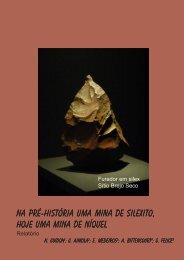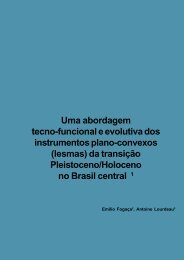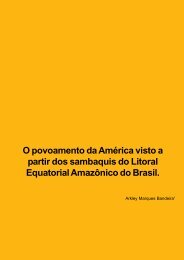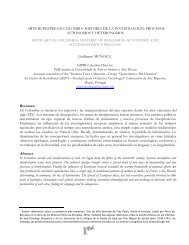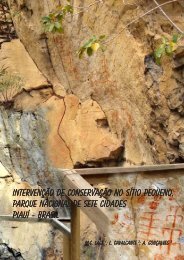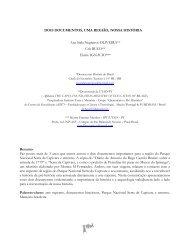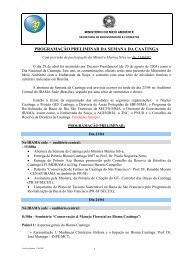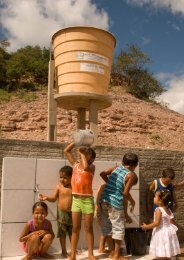Untitled - Fundação Museu do Homem Americano
Untitled - Fundação Museu do Homem Americano
Untitled - Fundação Museu do Homem Americano
You also want an ePaper? Increase the reach of your titles
YUMPU automatically turns print PDFs into web optimized ePapers that Google loves.
La figura humana en los petroglifos de la Cordillera de Chile Central. Una revisión<br />
José F. Blanco, Ángela Peñaloza & Magdalena de la Maza, Chile<br />
El arte rupestre de las montañas de Chile central es muy poco conoci<strong>do</strong> y sus sitios han si<strong>do</strong> escasamente<br />
publica<strong>do</strong>s y analiza<strong>do</strong>s. Esta situación es particularmente cierta si se refiere al río Maipo, una de las<br />
cuencas hidrográficas más importantes de la zona de valles centrales. Este trabajo analiza y discute la<br />
totalidad del arte rupestre conoci<strong>do</strong> para esta área. Constituye una puesta al día de los estudios en el<br />
tema, presentan<strong>do</strong> nueva <strong>do</strong>cumentación para un sitio recientemente redescubierto -tras 30 años de<br />
olvi<strong>do</strong>- y agregan<strong>do</strong> otro a la prehistoria del arte de la región. Se analizan aquí los contextos de paisaje<br />
en que se inserta dicho arte y se discuten las características de las imágenes en ellos, comparán<strong>do</strong>las<br />
con las de áreas vecinas. En particular, se presenta y discute la construcción de las representaciones<br />
humanas, su asociación a distintos motivos y su composición por paneles.<br />
Anthropomorfic Figures In Post-Paleolithic Paintings From The Northeast Of Portugal: Who Are<br />
They And What Doing?<br />
Sofia S. Figueire<strong>do</strong>, Portugal<br />
108<br />
Human representations began to appear in the Paleolithic period, and have always been under attention<br />
of archaeological studies. Focusing into the Iberian Peninsula, and the so-called schematic art, it is during<br />
Neolithic times that human representations increase, being current the findings of panels containing only<br />
this kind of motif. Humans normally appear as in a state or performance, dancing, gathering, hunting,<br />
among others activities. In this study we aim to discuss the ways of depicting humans in post-Paleolithic<br />
paintings from the Northeast of Portugal. We will center our attention in questions related to the position<br />
that those anthropomorphic figures occupy in panels and which other motives are mostly associated<br />
to them. Furthermore, the figures themselves can give us valuable information (i.e. gender or status)<br />
considering the attributes they display and the gestures they are performing. For the present work, five main<br />
sites, all with painted motifs, will be analyzed. “Penas Roias” is a small shelter in a cliff mainly decorated<br />
with anthropomorphic figures. “Forno da Velha” presents four different vertical panels with zoomorphic<br />
and anthropomorphic figures as well as geometrical symbols. “Serra de Passos” has a considerable<br />
number of shelters containing rock art but only one presents anthropomorphic figures. “Fraga d’Aia” is a<br />
granite shelter with a unique painting technique representing humans and a hunting scene. Finally “Foz<br />
Côa”, better known for its Paleolithic engravings, but which also contains post-Paleolithic paintings, has<br />
a place called “Faia”, where four rock formations display interesting human figures. Crossing different<br />
landscapes and post-Paleolithic chronologies we will draw attention to the importance of anthropomorphic<br />
representations as intended to express concepts, ideas and identities through self-perception.<br />
The Angelim Style of Northeast Brazil<br />
Reinal<strong>do</strong> Morales Jr., Esta<strong>do</strong>s Uni<strong>do</strong>s da América<br />
This paper will address a style of rock art in Northeast Brazil, the Angelim style, as a unique formal<br />
approach to the representation of anthropomorphic and zoomorphic imagery. The iconography typical of<br />
the Angelim style—frontal, elongated anthropomorphs, sometimes alone, sometimes in groups, stylized<br />
zoomorphs, also alone or in larger compositions—is shared with other regional styles. However, it is the<br />
manner in which this subject matter is presented—its style—that sets these aesthetic manifestations<br />
apart in the larger body of Brazilian rock art. While the issue of style as a carrier of meaning in pictures<br />
is frequently addressed in art-historical studies, this is still only marginally a part of anthropological and<br />
archaeological discourse on rock art. This paper will show how style itself may inform our understanding<br />
of the diversity of prehistoric picture-making in Northeast Brazil.<br />
FUMDHAMentos IX




